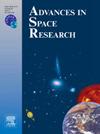Robust distributed autonomous orbit determination for LEO mega constellation based on inter-satellite ranging and astronomical measurement
IF 2.8
3区 地球科学
Q2 ASTRONOMY & ASTROPHYSICS
引用次数: 0
Abstract
Low earth orbit (LEO) satellites are pivotal for the development of mega satellite constellations (MSC), offering low latency and global coverage. However, the rising number of satellites in LEO MSC presents significant challenges, particularly in terms of computational burden and data processing requirements. In this study, a robust distributed autonomous orbit determination (AOD) for LEO MSC based on inter-satellite link (ISL) ranging and astronomical observations is proposed. Specifically, first, we fully consider the advantages of ISL observations in autonomous navigation, and utilize astronomical observations to compensate for the missing datum mark problem. Second, to address the significant computational burden resulting from the large number of satellites in the LEO MSC, a distributed AOD strategy that combines active and auxiliary satellites is given. In addition, the robust AOD method of balanced extended kalman filter (BEKF) for LEO MSC is derived. The results show that the proposed distributed strategy with robust parameters estimation method can achieve convergence time within 30 min even with up to 1600 satellites, while the traditional method needs over 240 min. In addition, the combination of ISL ranging for distance constraints and astronomical observations for directional constraints significantly enhances accuracy in T and N directions by approximately 20 %. Furthermore, the error accumulation effect is reduced by approximately 64 % compared to traditional methods as the number of satellites increases from 400 to 1600. Moreover, as the complexity of LEO MSC increases, the traditional amplified measurement covariance extended kalman filter (AMCEKF) method may become ineffective. However, the robust BEKF method enables satellites with lower orbit accuracy to make incremental adjustments, while satellites with higher orbit accuracy receive fewer adjustments. Therefore, the proposed robust method of BEKF balances orbit accuracy among satellites, and the stability of the BEKF method is improved compared to the traditional method.
基于星间测距和天文测量的低轨道大星座鲁棒分布式自主定轨
低地球轨道(LEO)卫星是巨型卫星星座(MSC)发展的关键,提供低延迟和全球覆盖。然而,LEO MSC卫星数量的增加带来了重大挑战,特别是在计算负担和数据处理要求方面。本文提出了一种基于星间链路(ISL)测距和天文观测的分布式自主定轨(AOD)方法。具体而言,首先,充分考虑ISL观测在自主导航中的优势,利用天文观测弥补基准标记缺失问题;其次,针对低轨道卫星系统中卫星数量庞大所带来的巨大计算负担,提出了一种主辅相结合的分布式AOD策略。在此基础上,推导了基于平衡扩展卡尔曼滤波(BEKF)的鲁棒AOD方法。结果表明,采用鲁棒参数估计方法的分布式策略可以在最多1600颗卫星的情况下实现30 min以内的收敛时间,而传统方法需要240 min以上的收敛时间。此外,结合ISL测距的距离约束和天文观测的方向约束,T和N方向的精度显著提高了约20%。此外,当卫星数量从400颗增加到1600颗时,与传统方法相比,误差累积效应降低了约64%。此外,随着LEO MSC复杂性的增加,传统的放大测量协方差扩展卡尔曼滤波(AMCEKF)方法可能会失效。然而,鲁棒的BEKF方法使轨道精度较低的卫星能够进行增量调整,而轨道精度较高的卫星能够进行较少的调整。因此,所提出的鲁棒BEKF方法平衡了卫星间的轨道精度,与传统方法相比,BEKF方法的稳定性得到了提高。
本文章由计算机程序翻译,如有差异,请以英文原文为准。
求助全文
约1分钟内获得全文
求助全文
来源期刊

Advances in Space Research
地学天文-地球科学综合
CiteScore
5.20
自引率
11.50%
发文量
800
审稿时长
5.8 months
期刊介绍:
The COSPAR publication Advances in Space Research (ASR) is an open journal covering all areas of space research including: space studies of the Earth''s surface, meteorology, climate, the Earth-Moon system, planets and small bodies of the solar system, upper atmospheres, ionospheres and magnetospheres of the Earth and planets including reference atmospheres, space plasmas in the solar system, astrophysics from space, materials sciences in space, fundamental physics in space, space debris, space weather, Earth observations of space phenomena, etc.
NB: Please note that manuscripts related to life sciences as related to space are no more accepted for submission to Advances in Space Research. Such manuscripts should now be submitted to the new COSPAR Journal Life Sciences in Space Research (LSSR).
All submissions are reviewed by two scientists in the field. COSPAR is an interdisciplinary scientific organization concerned with the progress of space research on an international scale. Operating under the rules of ICSU, COSPAR ignores political considerations and considers all questions solely from the scientific viewpoint.
 求助内容:
求助内容: 应助结果提醒方式:
应助结果提醒方式:


